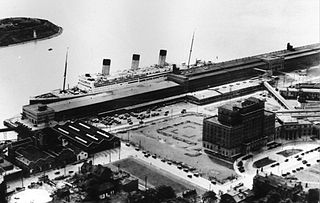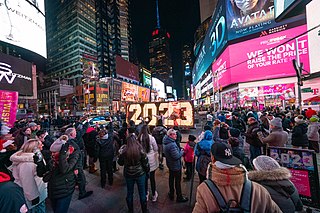
Ellis Island is a federally owned island in New York Harbor, situated within the U.S. states of New Jersey and New York. Ellis Island was once the busiest immigrant inspection and processing station in the United States. From 1892 to 1954, nearly 12 million immigrants arriving at the Port of New York and New Jersey were processed there. It has been part of the Statue of Liberty National Monument since 1965 and is accessible to the public only by ferry. The north side of the island is a national museum of immigration, while the south side of the island, including the Ellis Island Immigrant Hospital, is open to the public through guided tours.

The Statue of Liberty is a colossal neoclassical sculpture on Liberty Island in New York Harbor, within New York City. The copper-clad statue, a gift to the United States from the people of France, was designed by French sculptor Frédéric Auguste Bartholdi and its metal framework was built by Gustave Eiffel. The statue was dedicated on October 28, 1886.

Liberty Island is a federally owned island in Upper New York Bay in the northeastern United States. Its most notable feature is the Statue of Liberty, a large statue by Frédéric Auguste Bartholdi that was dedicated in 1886. The island also contains the Statue of Liberty Museum, which opened in 2019 and exhibits the statue's original torch.

Castle Clinton is a restored circular sandstone fort within Battery Park at the southern end of Manhattan in New York City, United States. Built from 1808 to 1811, it was the first American immigration station, predating Ellis Island. More than 7.5 million people arrived in the United States at Fort Clinton between 1855 and 1890. Over its active life, it has also functioned as a beer garden, exhibition hall, theater, and public aquarium. The structure is a New York City designated landmark and a U.S. national monument, and it is listed on the National Register of Historic Places.

Pier 21 is a former ocean liner terminal and immigration shed from 1928 to 1971 in Halifax, Nova Scotia, Canada. Nearly one million immigrants came to Canada through Pier 21, and it is the last surviving seaport immigration facility in Canada. The facility is often compared to the landmark American immigration gateway Ellis Island. The former immigration facility is now occupied by the Canadian Museum of Immigration, the Nova Scotia College of Art and Design as well as various retail and studio tenants.

The Manhattan Psychiatric Center is a New York-state run psychiatric hospital on Wards Island in New York City. As of 2009, it was licensed for 509 beds, but holds only around 200 patients. The current building is 17 stories tall. The building strongly resembles the main building of the Creedmoor Psychiatric Center in Queens. It is adjacent to Kirby Forensic Psychiatric Center, a specialized facility for patients with criminal convictions.

The Statue of Liberty National Monument is a United States national monument comprising Liberty Island and Ellis Island in the states of New Jersey and New York. It includes the 1886 Statue of Liberty by sculptor Frédéric Auguste Bartholdi and the Statue of Liberty Museum, both situated on Liberty Island, as well as the former immigration station at Ellis Island, which includes the Ellis Island Immigrant Hospital.

New York City received a ninth consecutive annual record of approximately 65.2 million tourists in 2018, the busiest tourist city attraction, and one of the world's overall busiest tourist attractions, counting not just overnight visitors but anyone visiting for the day from over 50 miles away, including commuters. Overall the city welcomed 37.9 million visitors who stayed overnight in 2018, of whom 13.6 million were international. Major destinations include the Empire State Building, Ellis Island, the Statue of Liberty on Liberty Island, Broadway theatre productions, Central Park, Times Square, Coney Island, the Financial District, museums, and sports stadiums. Other major visitor activities include luxury shopping along Fifth and Madison Avenues; entertainment events such as the Tribeca Film Festival; Randalls Island music festivals such as Governors Ball, Panorama and Electric Zoo; and free performances in Central Park at Summerstage and Delacorte Theater. Many New York City ethnic enclaves, such as Jackson Heights, Flushing, and Brighton Beach are major shopping destinations for first and second generation Americans.

Anna "Annie" Moore was an Irish émigré who was the first immigrant to the United States to pass through federal immigrant inspection at the Ellis Island station in New York Harbor. Bronze statues of Moore, created by Irish sculptor Jeanne Rynhart, are located at Cobh in Ireland and Ellis Island.

Angel Island Immigration Station was an immigration station in San Francisco Bay which operated from January 21, 1910, to November 5, 1940, where immigrants entering the United States were detained and interrogated. Angel Island is an island in San Francisco Bay. It is currently a State Park administered by California State Parks and a California Historical Landmark. The island was originally a fishing and hunting site for Coastal Miwok Indians, then it was a haven for Spanish explorer Juan Manuel de Ayala. Later, it was developed as a cattle ranch, then, starting with the Civil War, the island served as a U.S. Army post. During the island's Immigration Station period, the island held hundreds of thousands of immigrants, the majority from China, Japan, India, Mexico and the Philippines. The detention facility was considered ideal because of its isolated location, making it very easy to control immigrants, contain outbreaks of disease, and enforce the new immigration laws. The station is listed on the National Register of Historic Places under the title Angel Island, U.S. Immigration Station, and is a National Historic Landmark. The station is open to the public as a museum – "a place for reflection and discovery of our shared history as a nation of immigrants".

National Parks of New York Harbor is an office of the National Park Service that coordinates administration of eleven NPS sites, including 23 unique destinations located in the New York metropolitan area. National Parks of New York Harbor was formed in 2003 and administers properties ranging from the Statue of Liberty National Monument in New York Harbor to Gateway National Recreation Area in several locations and Saint Paul's Church National Historic Site in Mount Vernon, New York. Despite its name, technically the office does not oversee any national parks, but rather national monuments, national memorials, national historic sites, and a large national recreation area. Properties overseen by the office make up 27,000 acres (110 km2) and attract more than 12 million visitors each year. They are served by a visitor center at Federal Hall National Memorial.

The New York Landmarks Conservancy is a non-profit organization "dedicated to preserving, revitalizing, and reusing" historic structures in New York state. It provides technical and financial skills to owners of historic properties. In the half century since its 1973 founding, the conservancy has provided more than $60 million in grants and loans.

The Battery, formerly known as Battery Park, is a 25-acre (10 ha) public park located at the southern tip of Manhattan Island in New York City facing New York Harbor. It is bounded by Battery Place on the north, with Bowling Green to the northeast, State Street on the east, New York Harbor to the south, and the Hudson River to the west. The park contains attractions such as an early 19th-century fort named Castle Clinton; multiple monuments; and the SeaGlass Carousel. The surrounding area, known as South Ferry, contains multiple ferry terminals, including the Staten Island Ferry's Whitehall Terminal; a boat launch to the Statue of Liberty National Monument ; and a boat launch to Governors Island.

The Ellis Island Immigrant Hospital was a United States Public Health Service hospital on Ellis Island, in New York Harbor, that operated from 1902 to 1951. The hospital is part of the Statue of Liberty National Monument. While the monument is managed by the National Park Service as part of the National Parks of New York Harbor office, the south side of Ellis Island, including the hospital, is managed by the non-profit Save Ellis Island Foundation and has been off-limits to the general public since its closing in 1954.
New Jersey v. New York, 523 U.S. 767 (1998), was a U.S. Supreme Court case that determined that roughly 83% of Ellis Island was part of New Jersey, rather than New York State.

The Immigration Act of 1891, also known as the 1891 Immigration Act, was a modification of the Immigration Act of 1882, focusing on immigration rules and enforcement mechanisms for foreigners arriving from countries other than China. It was the second major federal legislation related to the mechanisms and authority of immigration enforcement, the first being the Immigration Act of 1882. The law was passed on March 3, 1891, at the end of the term of the 51st United States Congress, and signed into law by then United States President Benjamin Harrison.
Ludmila Kuchar Foxlee was a social worker at the Ellis Island immigration station. Employed by the YWCA after World War I, Foxlee spent time in Czechoslovakia to assist in rebuilding efforts before working at Ellis Island from 1920 to 1937. She became one of the most well-known immigrant aid workers and her meticulous notes are currently stored at the Ellis Island archives.

The State Emigrant Refuge and Hospital was a New York State immigration complex located on Wards Island in New York City. Established in 1847, it primarily consisted of a public shelter and a hospital, later known as the Verplanck State Emigrant Hospital, both of which served recent immigrant arrivals to the Port of New York. The complex was operated under the authority of the New York State Board of Commissioners of Emigration as part of a network of state-run immigration facilities, which included the State Emigrant Landing Depot at Castle Garden in Lower Manhattan. Recent immigrants to New York were entitled to services at the State Emigrant Refuge and Hospital for up to five years after their arrival.


















